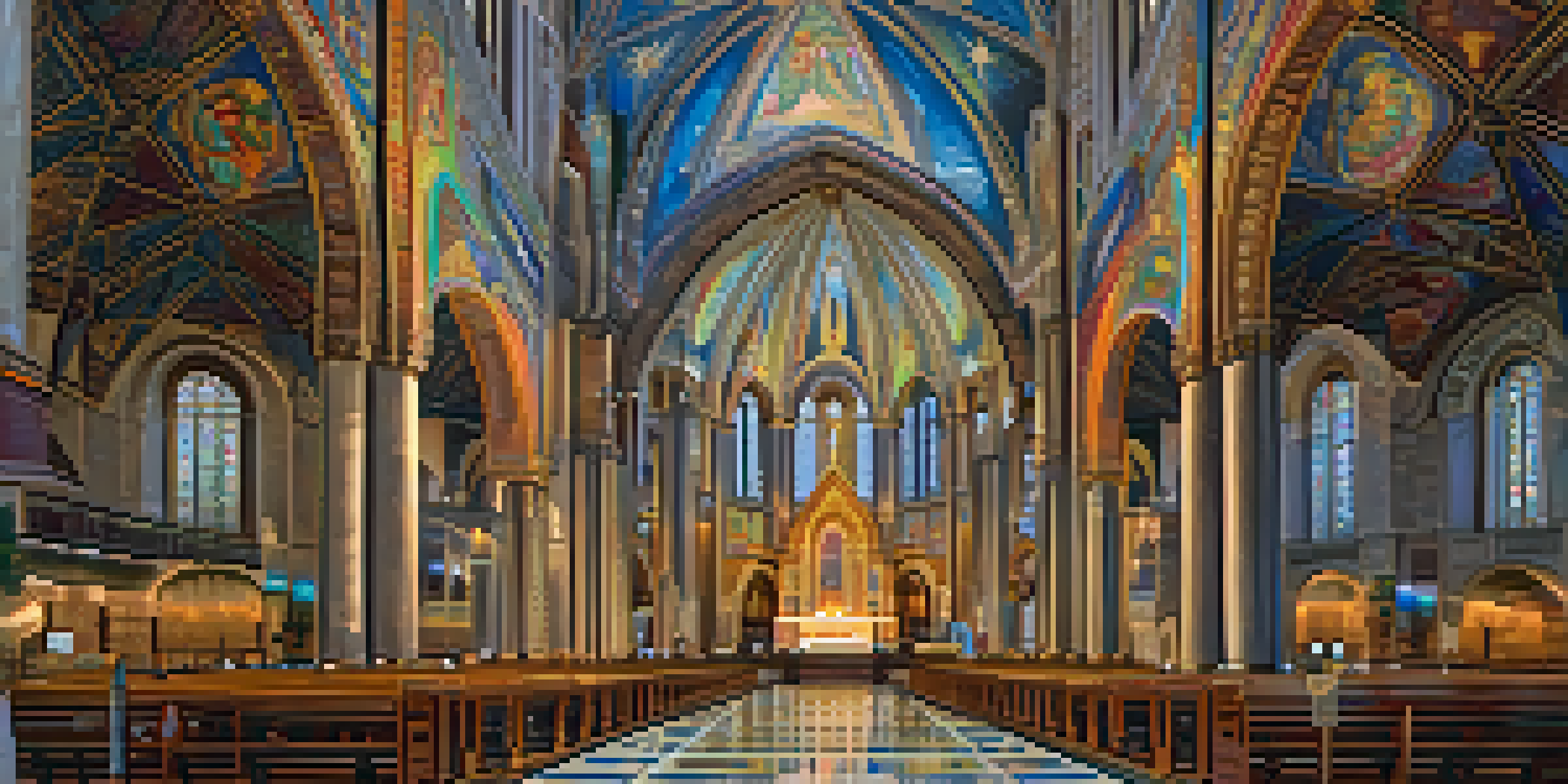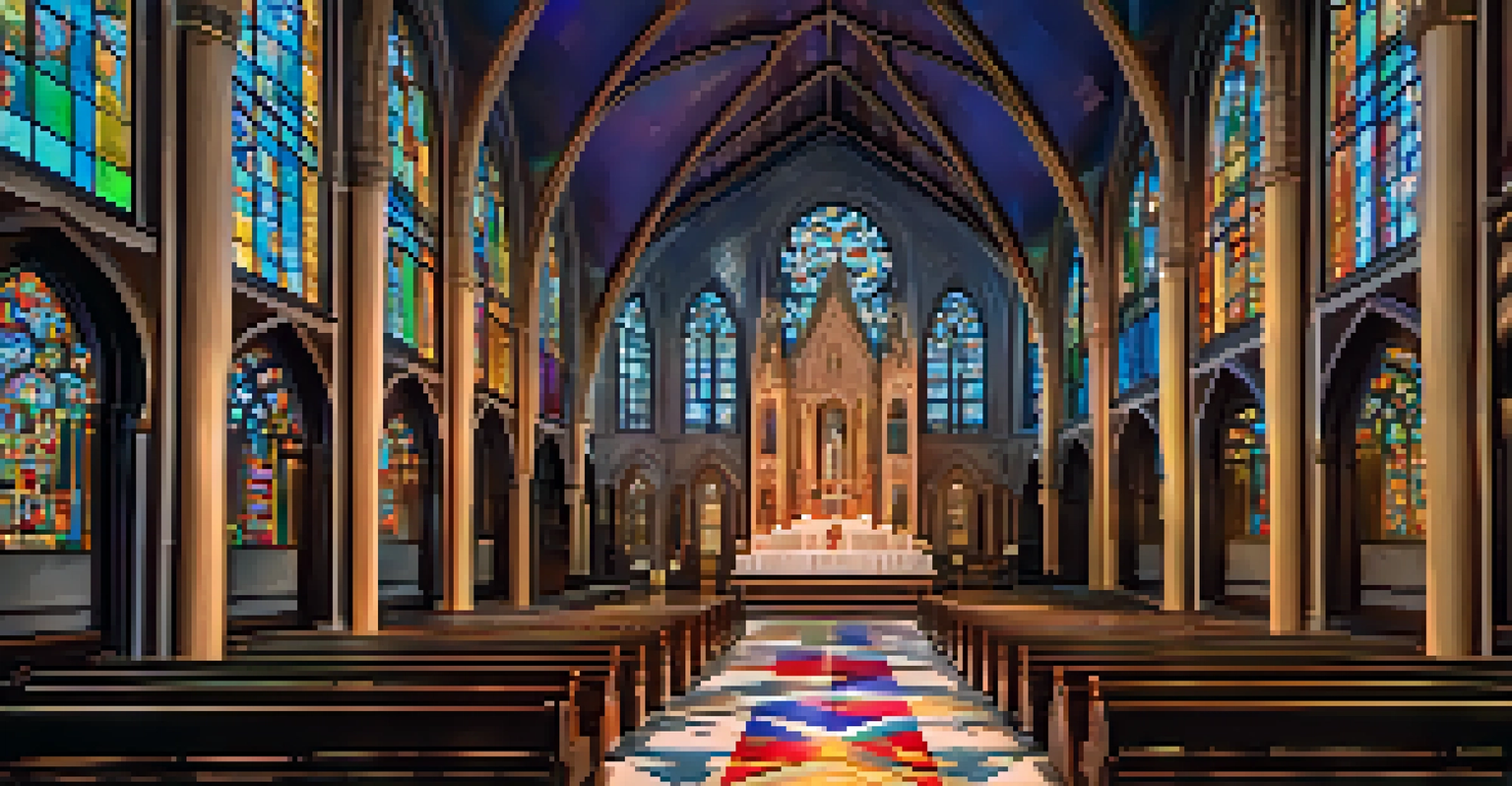Iconic Churches and Their Architectural Styles in St. Louis

The Historic Cathedral Basilica of St. Louis
The Cathedral Basilica of St. Louis is a stunning example of Byzantine architecture. Its mosaic interior, featuring over 41 million tiles, captivates visitors with its vibrant colors and intricate designs. Completed in 1914, the cathedral serves as the mother church of the Archdiocese of St. Louis and is a true testament to the city’s rich religious history.
Architecture is the learned game, correct and magnificent, of forms assembled in the light.
One of the most striking features of the basilica is its massive dome, which rises 200 feet above the ground. This architectural marvel is not only a focal point for the building but also for the skyline of St. Louis. The blend of Romanesque and Byzantine styles creates a unique aesthetic that draws admiration from both locals and tourists alike.
Visitors often find themselves awed by the serene atmosphere inside, making it a perfect spot for reflection and worship. The cathedral's art and architecture tell the story of faith and craftsmanship, showcasing the dedication of those who built it. It's a must-see destination for anyone interested in the intersection of spirituality and art.
St. Francis de Sales Oratory: A Gothic Revival Gem
St. Francis de Sales Oratory is a hidden gem of Gothic Revival architecture nestled in St. Louis. Built in the late 19th century, the church features breathtaking stained glass windows that tell biblical stories, allowing light to dance through the space in vibrant hues. Its intricate stonework and soaring arches create a sense of grandeur that is both inviting and awe-inspiring.

This oratory is not just architecturally significant; it also serves a vibrant community of worshipers. Regular services and special events draw in people from all walks of life, fostering a sense of belonging and shared faith. The mix of architectural beauty and community spirit makes it a vital part of the local landscape.
St. Louis Churches Showcase Diversity
The various churches in St. Louis reflect a rich tapestry of architectural styles, from Byzantine to Gothic Revival, highlighting the city's diverse religious heritage.
Visitors often find themselves captivated by the details, from the ornate altar to the meticulously crafted statues. It’s a place where history and spirituality converge, reminding us of the enduring power of faith expressed through art. A trip to this oratory enriches the understanding of St. Louis's religious heritage.
The Impressive St. Louis Cathedral: A Blend of Styles
The St. Louis Cathedral, also known as the Cathedral of Saint Louis, is a stunning blend of architectural styles, primarily Romanesque and Byzantine. Its grand façade and striking bell tower make it a prominent feature of the city’s skyline. Completed in 1889, it has become a symbol of the city’s deep-rooted Catholic traditions.
The essence of architecture is the spirit of the place, which is a manifestation of the people who inhabit it.
Inside, the cathedral's beauty continues with its high ceilings and expansive nave, which creates an atmosphere of reverence. The use of marble and decorative frescoes enhances the sense of sacredness, inviting visitors to pause and reflect. This architectural masterpiece not only serves as a church but also as a cultural landmark in St. Louis.
The cathedral hosts various events and services, drawing in locals and tourists alike. It stands as a testament to the city’s architectural diversity and the rich history of its religious institutions. Exploring its beauty offers a glimpse into the spiritual and artistic journey of St. Louis.
Old Cathedral: A Testament to Resilience
The Old Cathedral, or the Basilica of Saint Louis, King of France, is the city's oldest church and a remarkable piece of history. Built in the early 1800s, it reflects the Classical Revival style, featuring a simple yet elegant design. Surviving the tumultuous times of the past, it stands as a testament to the resilience of the St. Louis community.
Inside, the cathedral is adorned with beautiful artwork and historical artifacts that tell the story of its past. The serene atmosphere invites visitors to explore its rich heritage while contemplating the significance of faith in the city’s development. It’s a place where history and modern spirituality coexist harmoniously.
Community Connection Through Faith
Many of these historic and modern churches serve as vital community hubs, fostering a sense of belonging and engagement among worshipers.
As the city has grown and changed around it, the Old Cathedral remains a cherished landmark. Its continued use for worship and community events highlights its importance to both the local culture and the wider religious community. Visiting the Old Cathedral offers a unique perspective on the evolution of St. Louis’s architectural landscape.
St. John the Apostle Church: Modern Style Meets Tradition
St. John the Apostle Church showcases a modern architectural style while honoring traditional elements. Built in the late 20th century, its design incorporates clean lines and open spaces, creating a welcoming environment for worship. This blend of contemporary and classical influences reflects the evolving nature of faith communities in St. Louis.
The interior is designed to foster a connection among parishioners, with a layout that encourages engagement during services. Artistic features, such as modern stained glass and thoughtful sculptures, enhance the spiritual atmosphere. It’s a space where tradition meets innovation, making it a unique addition to St. Louis’s church landscape.
As a community hub, St. John the Apostle Church hosts various activities and outreach programs, emphasizing service and connection. The church's architecture not only serves its purpose but also inspires a sense of belonging among its members. This modern church captures the spirit of a dynamic and inclusive faith community.
The Enigmatic Shrine of St. Joseph: A Baroque Treasure
The Shrine of St. Joseph is a Baroque-style church that enchants visitors with its ornate design and rich history. Established in the mid-19th century, the shrine features intricate woodwork and lavish decorations that reflect the grandeur of the Baroque period. It stands as a tribute to the dedication of the local community to their faith and heritage.
One of the most captivating aspects of the shrine is its stunning altar, adorned with statues and elaborate carvings that draw the eye. The use of color and detail creates an atmosphere of reverence and beauty, inviting contemplation and prayer. This unique architectural style sets the shrine apart from many other churches in the area.
Artistry in Religious Architecture
The intricate designs and artistic features of St. Louis's churches not only enhance spiritual experiences but also celebrate the craftsmanship and dedication of local artisans.
Today, the Shrine of St. Joseph serves as a place of pilgrimage for those seeking solace and connection. Its historical significance and architectural splendor make it a must-visit destination in St. Louis. Exploring the shrine allows visitors to appreciate the artistic legacy of religious architecture in the city.
The Contemporary Design of St. Louis University’s Chapel
St. Louis University's Chapel is a striking example of contemporary design that integrates modern aesthetics with spiritual purpose. The chapel's sleek lines and innovative use of materials create an inviting space for both students and visitors. This modern approach reflects the university's commitment to fostering a vibrant faith community.
Inside, the chapel is bright and airy, with large windows that allow natural light to fill the space. This openness encourages a sense of peace and reflection, making it a popular spot for students seeking solace amidst their busy lives. The design emphasizes inclusivity, inviting people from all backgrounds to experience its spiritual offerings.

As a hub for campus life, the chapel hosts various services, events, and gatherings, reinforcing its role in the university community. Its contemporary architecture not only serves practical needs but also inspires engagement and connection. A visit to the chapel reveals how modern design can enhance the experience of faith and community.